By Roman Hands
Inscriptions and Graffiti for Students of Latin Second Edition
By Roman Hands
Inscriptions and Graffiti for Students of Latin Second Edition Matthew Hartnett
 By Roman Hands
By Roman Hands 2012 Matthew Hartnett Focus Publishing/R. Pullins Company PO Box 369 Newburyport, MA 01950 www.pullins.com ISBN 978-1-58510-698-1 Also available in paperback (ISBN 978-1-58510-402-4). To see all available eBook versions, visit www.pullins.com. Some content that appears in the print edition may not be available in other formats. All rights are reserved. No part of this publication may be reproduced, stored in a retrieval system, or transmitted in any form or by any means, electronic, mechanical, by photocopying, recording, or by any other means, without the prior written permission of the publisher.
If you have received this material as an examination copy free of charge, Focus Publishing/R. Pullins Company retains the title to the information and it may not be resold. Resale of any examination copies of Focus Publishing/R. Pullins Company materials is strictly prohibited. Last updated March 2013 Grammatical Table of ContentsThematic Table of ContentsLove and Hate 4, 5, 9, 20, 32, 52, 60, 91, 120-122, 127-130, 154, 157-159, 168 Gladiators, Musicians and Other Entertainers 19, 20, 23, 33, 36-39, 58, 59, 66, 101, 162 Myth and Religion 2, 6, 10, 17, 22, 28, 34, 63, 69, 79, 81, 94-97, 102, 103, 120, 126, 132, 147, 149, 155, 162 Government, Administration and Politics 1, 34, 42, 114, 115, 139, 145, 153, 163, 168 Slaves and Freedmen 13, 29, 55, 64, 66, 71, 82, 83, 135, 145, 151, 156, 166, 167 Soldiers and Emperors 16, 68, 74, 79, 94, 95, 100, 102, 103, 118, 134, 144, 155, 163 Women 4, 23, 26, 29, 31, 32, 35, 38, 43, 60, 64, 66, 72, 81-83, 87, 90, 105, 108, 111, 116, 141, 156, 167 Children 14, 26, 27, 48, 51, 53, 57, 66, 72, 73, 85, 87, 90, 106, 107, 109, 112, 116, 140, 145, 162 The Roman Way of Life 4, 5, 8, 10, 11, 13, 21, 25, 27, 31-33, 41, 44-48, 54, 60, 61, 74-76, 78, 84, 88, 89, 101, 108, 110, 118, 120-123, 126-128, 131, 136, 139, 141, 150, 156, 159, 162, 164-168 The Roman Way of Death 3, 7, 8, 12, 14, 15, 18, 24, 30, 40, 41, 49, 50, 56, 62, 65, 67, 69, 70, 74-78, 80, 81, 85, 86, 91-93, 96-99, 104, 106, 108, 112, 113, 117, 124, 125, 129, 130, 132, 133, 137, 138, 140, 142, 143, 146-148, 151, 152, 160, 161, 164-168 Preface to the First Edition The aim of this book is to provide students and teachers with a collection of Roman inscriptions and graffiti that illustrate basic elements of Latin grammar and syntax and, at the same time, illuminate interesting and important aspects of Roman history and culture. By Roman Hands is built on three premises: First, students do not need to wait until the third year of high school or the second year of college study to grapple with authentic Latin.
If the texts are well chosen and equipped with running vocabulary and suitable notes, students are not only capable of comprehending them, but will advance more quickly to legitimate facility with the language by being exposed to real Latin early on. Second, inscriptions and graffiti provide brief, clear and self-contained examples of good Latin in actual use, and serve as vivid introductions to fascinating aspects of Roman history, life and thought. Third, a student who is given the opportunity to hone his translation skills on examples of Latin left by actual Roman hands will be excited by the directness of his engagement with the ancient world and will find his study of Latin more enjoyable and rewarding as a result. Latin teachers regularly intone that learning the language well is the key to understanding the Romans. But students at the early levels, who test their mettle against passages of artificial Latin for the most part, and who quickly come to associate forays into history and culture with taking a break from their Latin, have reason to doubt whether their labors are getting them any closer to the Romans. A student will, however, truly appreciate the value of her efforts when mastery of a grammar lesson affords her direct access to an actual moment in Roman timewhen knowing the difference between the ablatives of means and personal agent enables her to see what killed a gladiator from Dacia (); when construing an ablative absolute correctly means appreciating how skillfully Octavian could turn civil war into propaganda (); when properly identifying a condition opens a window into the mind of a frustrated traveler desperate to see his beloved ().
While the constraints of class period and semester never make it easy to incorporate more material into the curriculum, any exercise that simultaneously combines reinforcement of grammar, exposure to authentic Latin and insight into Roman culture surely merits comparison with any competing use of time. This book can be used in a number of ways: as a reservoir of examples for reinforcing grammar points as they are introduced; as a supplement to the translation exercises in the regular textbook; as a source of additional assignments for more able or energetic students; as a tool to aid students in preparing for periodic major exams; or as a comprehensive review of basic grammar and syntax for students who are about to embark on the translation of extended passages of Latin literature for the first time. To facilitate ease of use within the parameters of class time, the inscriptions have on the whole been kept on the shorter side, either by selection or by the careful excerption of brief sense units from longer texts. Each inscription is represented first in a form that approximates the appearance of the lettering on the original object, and then in an edited version that will be more familiar and accessible to students. The goal here is to permit students to see Latin as it was actually written by the Romans, without demanding of them the specialized skills of a trained epigrapher. If exposure to these inscriptions sparks an interest in pursuing epigraphy further, that can only be counted a benefit, and the Suggestions for Further Reading will provide curious students with wonderful places to continue their investigation.
Each selection is followed by a brief commentary that elucidates cultural and historical matters germane to the interpretation of the text, draws attention to noteworthy features of language or thought, and orients the student to the context of the message being conveyed. This is followed by a running vocabulary of all but the most common or easily intuited words, combined with notes that explain obscure grammar and offer translation help where needed. The vocabulary and notes offer more support in Parts 1 and 2 to assist the student just embarking on the study of Latin, and gradually less in Parts 3 and 4, when knowledge of the preceding grammar and syntax is assumed, along with a wider familiarity with the most commonly used Latin words. At the back of the book there is a comprehensive vocabulary that glosses every word used in the inscriptions, along with a grammatical index that cites every inscription illustrating a given grammar point. Many of the texts are illustrated by photos or line drawings of the originals. For teachers who prefer to access the inscriptions by theme, a Thematic Table of Contents is provided in addition to the Grammatical Table of Contents.
In addition, thematic cross-references in the commentary assist students in comparing inscriptional evidence and drawing broader conclusions about the nature of Roman history, life and thought. Thanks are due to the donors of the Barlow Chair and the Loudon Fund at St. Marks School and to the staffs of the Widener Library at Harvard University, the Clapp Library at Wellesley College, and the St. Marks School Library. I wish to extend my deep appreciation to David Conti, Ed DeHoratius, George Franko, Richard Geckle and James Kothe for reading and commenting on earlier drafts of this work. I must also acknowledge my debt to Torey Akers for her excellent line drawings and to Helen Pope of St.
Next page
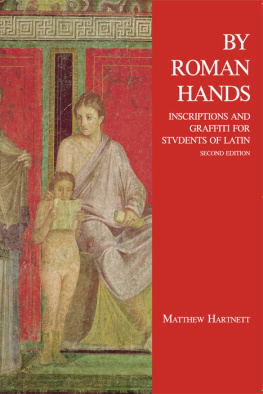
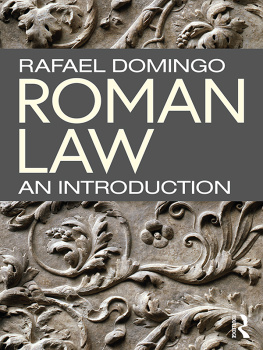

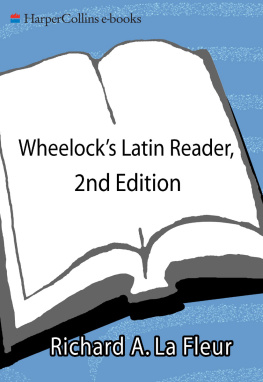
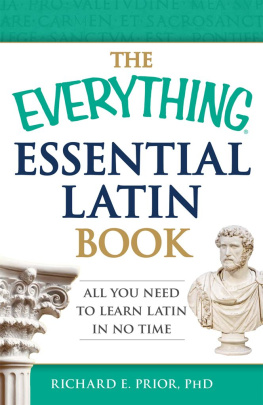
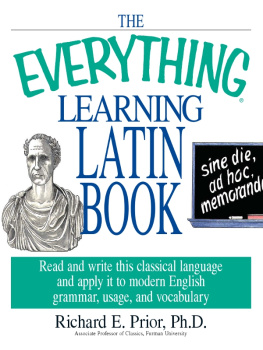
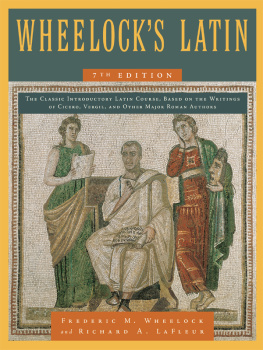
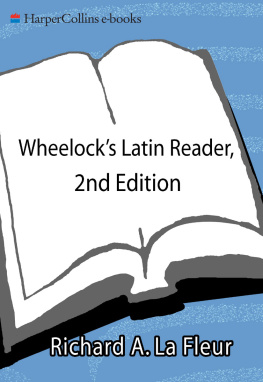
 By Roman Hands 2012 Matthew Hartnett Focus Publishing/R. Pullins Company PO Box 369 Newburyport, MA 01950 www.pullins.com ISBN 978-1-58510-698-1 Also available in paperback (ISBN 978-1-58510-402-4). To see all available eBook versions, visit www.pullins.com. Some content that appears in the print edition may not be available in other formats. All rights are reserved. No part of this publication may be reproduced, stored in a retrieval system, or transmitted in any form or by any means, electronic, mechanical, by photocopying, recording, or by any other means, without the prior written permission of the publisher.
By Roman Hands 2012 Matthew Hartnett Focus Publishing/R. Pullins Company PO Box 369 Newburyport, MA 01950 www.pullins.com ISBN 978-1-58510-698-1 Also available in paperback (ISBN 978-1-58510-402-4). To see all available eBook versions, visit www.pullins.com. Some content that appears in the print edition may not be available in other formats. All rights are reserved. No part of this publication may be reproduced, stored in a retrieval system, or transmitted in any form or by any means, electronic, mechanical, by photocopying, recording, or by any other means, without the prior written permission of the publisher.